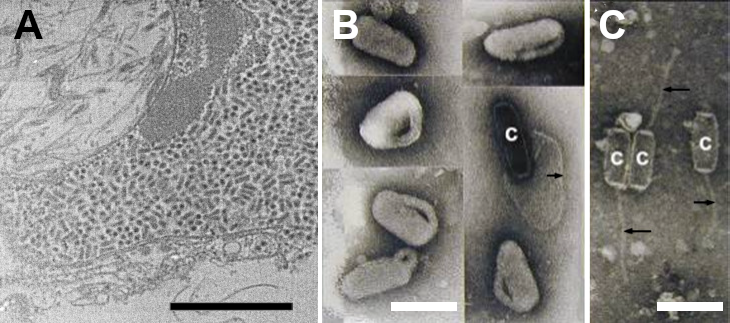Family: Nudiviridae
Genus: Alphanudivirus
Distinguishing features
Virions are relatively compact, measuring 90–120 nm x 180–220 nm. Alphanudiviruses have been isolated from insects of the orders Coleoptera, Diptera, and Orthoptera. Oryctes rhinoceros nudivirus (OrNV) infection of larvae spreads from the midgut to other tissues and results in mortality, while infection of the adults is usually persistent and constrained to the midgut. Progeny virus from sloughed midgut cells is defecated by OrNV-infected adults (Huger 1966). Gryllus bimaculatus nudivirus (GbNV) establishes lethal infections of field crickets and replicates in the host fat body (Huger 1985). Drosophila innubila nudivirus (DiNV) was isolated from wild caught flies (Unckless 2011). The four Drosophila melanogaster-infecting nudiviruses Kallithea virus, Tomelloso virus, Esparto virus and Mauternbach virus (Webster et al., 2015, Palmer et al., 2018, Wallace et al., 2021), also belong to this genus and have been classified as members of the species Alphanudivirus dromelanogasteris, Alphanudivirus alterdromelanogasteris, Alphanudivirus tertidromelanogasteris and Alphanudivirus quartudromelanogasteris, respectively.
Virion
For general features see the discussion under family properties. Nucleocapsids of OrNV have a distinctive tail-like appendage (Figure 1.Alphanudivirus). Such appendage is however not a general feature of alphanudiviruses.
 |
|
Figure 1.Alphanudivirus. (A) Virions of Oryctes rhinoceros nudivirus (OrNV) filling the nucleus in infected cells after injection of OrNV into O. rhinoceros. (B) Negatively-stained virions of OrNV, with one nucleocapsid (c) emerging from its associated envelope (arrow). (C) Nucleocapsids (c) of OrNV with tail-like appendages visible (arrows). Scale bars: (A) 2 µm; (B) and (C) 0.2 µm. Micrograph (A) was supplied by Madoka Nakai. Micrographs in (B) and (C) were modified and reprinted from (Huger 2005) Copyright 2005, with permission from Elsevier. |
Genome organization and replication
Genome sizes and GC content vary considerably. The OrNV-Ma07 genome (Figure 1.Nudiviridae) is 127 615 bp with a GC content of 41.6% and encodes 139 ORFs (Wang et al., 2011). The smallest genome (96 944bp) has been found for GbNV with a GC content of 28% and 98 ORFs (Wang et al., 2007b). Esparto virus so far has the largest alphanudivirus genome with a size of 183 kbp (Wallace et al., 2021).
Biology
GbNV infects at least four different species of crickets (Huger 1985). In nature OrNV infections have been reported from O. rhinoceros (Scarabaeidae, Dynastinae) only. However, OrNV can also productively infect the cell line DSIR-HA-1179 from Heteronychus arator, which also belong to the subfamily Dynastinae (Crawford 1982), as well as FRI-AnCu-35 cells derived from Anomala cuprea, which is more distantly related as it belong to the Rutelinae subfamily within the Scarabaeidae (Tanaka et al., 2021) (Figure 1.Alphanudivirus). Different strains of OrNV with different genotypes and different levels of virulence towards O. rhinoceros have been described (Ramle et al., 2005). DiNV is rather common in wild populations of Drosophila innubila and D. falleni. The virus has a severe effect on fecundity and reduce lifespan (Unckless 2011). Virus particles for DiNV were found in faecal samples with capsids of 120 × 30 nm, relatively small for nudiviruses (Unckless 2011).
Species demarcation criteria
Species demarcation criteria are not well-defined. The species of Alphanudivirus are distinguished on the basis of differences in genome size and G+C content, gene content and arrangement, phylogenetic relationships, host tropism, pathobiology, and virus transmission.
Related, unclassified viruses
|
Virus name |
Accession number |
Virus name abbreviation |
Reference |
|
Diabrotica undecimpunctata howardi nudivirus |
DuhNV |
||
|
Diabrotica virgifera virgifera nudivirus* |
Data available online at https://www.mdpi.com/1999-4915/13/2/269/s1. |
DvvNV |
|
|
Osmia cornuta nudivirus |
Data available from « Ocor » libraries at https://figshare.com/s/13f0bac389b1188133d5 |
OcNV |
Virus names and virus abbreviations are not official ICTV designations.
*Not included in the phylogeny (Figure 2.Nudiviridae) as only 13 of its core genes have been sequenced so far.

